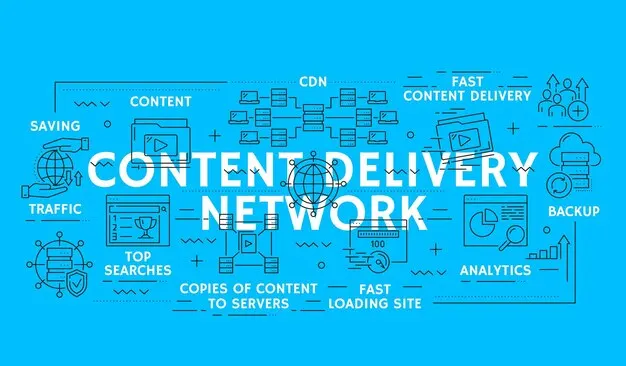Imagine you’re about to watch a live concert or sports event online, but instead of a smooth video, you get endless loading and blurry images. Frustrating, right? This is where Content Delivery Networks (CDNs) come in. Whether it’s video streaming or online gaming, the need for high-quality content delivery is growing. CDNs help ensure that viewers can access content smoothly, without interruptions.
But what are CDNs, and how do they improve streaming? In this blog, you will read about this technology that how it makes online experiences faster and better!
Table of Content:
What is a Content Delivery Network (CDN)?

A content delivery network is a network of interconnected servers, placed across the globe that speeds up webpage loading for heavy data applications. Content delivery is also known as content distribution network. CDNs are known in the late 1990s to help in the slow internet. Especially when the internet is becoming more important for businesses and a single user.
It stores the web content in its server so it can deliver data speedily. When a user visits a website page, the content from website servers has to move around the internet. A CDN allows for the quick transfer of assets that are needed for loading Internet content, including HTML pages, JavaScript files, stylesheets, images, and videos. Content Distribution Network (CDN) is an efficient method for improving Internet service quality.
CDN performance is expected to significantly improve with the introduction of 5G technology improving streaming performance. 5G provides quick and fast speeds which enhance streaming. CDNs will have to update their infrastructure to allow for greater storage capacities as the demand for ultra-HD content increases over 5G networks.
The Importance of Streaming Performance
Streaming Performance is an important aspect of today’s digital world. Especially for those developers and businesses who are looking to apply the streaming technology. As the need for live videos, music, and other real-time content grows, it’s important to understand what streaming performance includes.
Viewers, more expects seamless content delivery, whether they’re watching a live Video or binge-watching their favorite series or movie. This significant for individual developers and small to mid-sized businesses. The Importance of streaming performance is as follows:
- User Satisfaction: A flawless streaming experience means to better user experience. Users are more probably to return to a platform that delivers high-quality content without interruptions. User satisfaction is the fulfilment of the user’s needs, expectations, and preferences through a better user experience.
- Competitive advantage: Excellent streaming performance can differentiate your product in this crowded market. Prioritizing performance helps businesses keep more customers which promotes expansion and success.
- Quality Beyond Resolution: High streaming quality isn’t just about resolution; it also covers speed and reliability. Audiences thrive on instant access to content with minimal latency reduction.
- Global Content Delivery: Todays digital world can make or break a company’s reputation depends on how users interact with it. Continually providing high-performance streaming can build user trust and increase the legitimacy of your brand.
How CDNs Work in Streaming Performance

A CDN, or content delivery network, is a distributed network of servers that deliver digital content (video, image, another webpage, etc.) to users in a more effective and timely manner. The purpose of a CDN will be to reduce latency, increase speed, and improve the quality of the content delivery experience, especially when reaching large-scale traffic.
1. Content Distribution
A CDN has edge servers placed at various locations worldwide. Edge servers are cache servers close to end users that store copies of content (e.g., videos, images, web pages) closer to the end users. With CDN, when a user requests content, it is routed to the nearest edge server. A CDN helps reduce the time it takes for data to travel by delivering content from a server.
2. Origin Server
The original content is kept up-to-date and stored on the origin server. The main server or headquarters that manage the storage transcoding and content updates is usually this one. The edge servers ensure quick delivery by transferring the content across several locations. On the other, the origin server manages the majority of the content creation and updates.
3. Edge Servers and Caching
Edge servers as well as cache. Usually found at Internet exchange points (IXPs) or other network hubs. Edge servers are cache servers that keep copies of content closer to users. By using caching a user’s request for a piece of content can be speedily fulfilled by the closest edge server instead of a lengthy journey back to the origin server.
4. Internet Exchange Points (IXPs)
CDNs connect their edge servers to Internet Exchange Points (IXPs) to speed up the delivery of content. IXPs are hubs that allow various internet providers to connect and share traffic. In order to ensure faster and more effective data delivery CDN providers can connect to IXPs and avoid using regular internet routes. This speeds up and lowers the cost of content delivery by cutting down on travel times and delivery expenses.
5. Routing requests and load balancing.
The CDN employs smart order routing to route user content requests to the nearest or low crowded edge server. Effective traffic management requires dynamic routing. The Content Delivery Network can quickly switch traffic to another server if one becomes unavailable or overloaded ensuring that the user experience is not severely disrupted. For content delivery this is referred to as load balancing and it helps in ensuring high availability and dependability.
6. Adaptation in Real Time.
In real time CDNs continuously estimate and adjust to network conditions. The Content Delivery Network can automatically reroute requests to other servers in the event that a specific edge server is having problems or is flooded with traffic ensuring load-free content delivery. This real-time modification improves the content delivery speed.
7. safety. CDNs are also essential for improving security.
To avoid errors they frequently offer Web Application Firewalls (WAF) SSL encryption and DDoS protection. Large-scale attacks can be held and their effects are reduced by CDNs by dividing traffic among several servers. It guarantees that the end-user experience is unaffected.
8. Reach Worldwide.
The global reach of a CDN is one of its main benefits. Through content distribution across several regions a Content Delivery Network can offer a consistent and quick experience to users in various geographic locations. Regardless of user location is in relation to the origin server, the CDN guarantees that content is delivered speedily and consistently whether they are in Berlin Tokyo or New York.
Types of CDNs: Edge Computing vs. Peer to Peer Network
What is edge Computing
By processing data closer to its source rather than sending it all to a central data center edge computing is a system. This enables companies to better manage their resources and develop better user experiences such as independent vehicles or intelligent machinery. Data transfer to a central server can be a slow and detailed resource. By processing data close by edge computing removes delays and speeds up operations. Businesses can analyze data more quickly with 5G and mobile edge computing which improves customer experiences and leads to better insights and quicker responses.
What is Peer to Peer Network
In peer-to-peer (P2P) networks users exchange information directly with one another rather than through a central server. These networks are growing in popularity as informational tools and may play a significant role in business knowledge sharing. While P2P networks are accessible to all they differ from public goods in other ways as well. P2P networks operate without central control as do mobile ad hoc networks (MANETs). Although they function on distinct network layers merging the two can result in issues as well as new services. The Mobile Peer-to-Peer (MPP) protocol is a novel solution to this issue. MPP attempts to make use of current protocols by operating from the network layer to the application layer.
Factors to Consider When Choosing a CDN for Streaming
The following are some things to think about when selecting a streaming Content Delivery Network.
- Worldwide Network Access. : Select a Content Delivery Network with servers near your target audience. Fast content delivery is ensured by a global network of servers that speed up page loads and minimize latency.
- Performance as well as speed: A CDN that guarantees fast loading times is what you want. Look for low Time to First Byte (TTFB) and support for contemporary protocols such as QUIC and HTTP/3 to ensure faster delivery of content.
- Features for Security: Security is of the essence. Make sure the Content Delivery Network has web application firewalls SSL/TLS encryption DDoS protection and access controls like IP and geo-blocking.
- Reporting and Analysis: Select a Content Delivery Network with reporting features that aid in cost management performance monitoring and problem solving. Maintaining high service quality can be aided by real-time analytics.
- Optimizing content is important: Seek out CDNs that optimize pictures videos and scripts. Compression tools enhance user experience and page load times while optimizing video streaming guarantees fluid playback.
- Its cost-effective: Make sure the CDN has flexible plans that increase in size in tandem with your traffic and clear pricing. Pay-as-you-go pricing helps cut down on wasteful expenses.
- Customer Support and Documentation: For round-the-clock support choose a Content Delivery Network. Good self-service tools manuals and tutorials will assist your team in effectively optimizing the network.
Future of CDNs in Streaming Technology

- An excellent illustration of how Content Delivery Network technology can enhance video streaming is Netflix. To improve the user experience Netflix moved to Amazon Web Services (AWS) and developed its own Netflix’s Content Distribution System.
- Netflix’s Content Distribution System distributes content using intelligent algorithms and splits Netflix’s infrastructure into smaller more effective micro servers. By using this technique buffering times are decreased and faster more dependable streaming is guaranteed for users worldwide.
- Because of Netflix’s CDNs worldwide reach customers can enjoy uninterrupted high-quality streaming wherever they are. With this strategy Netflix scales to accommodate the needs of its expanding user base while simultaneously delivering content effectively.
Conclusion
In conclusion, Content Delivery Networks (CDNs) are essential for improving streaming on a variety of platforms. To guarantee that users have flawless video streaming experiences they address the problems of loading and inactivity reduction. CDNs improve load balancing and network efficiency by distributing content via servers that are positioned strategically. Global reach and content availability are becoming more and more important as online consumption keeps growing. Businesses aiming to maximize their streaming services should evaluate different CDN providers according to their particular requirements. The environment is always changing as technological breakthroughs continue to influence the way we consume media.
